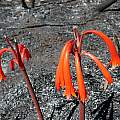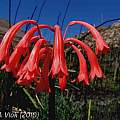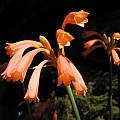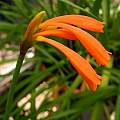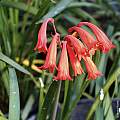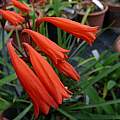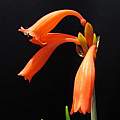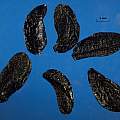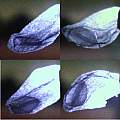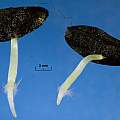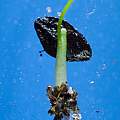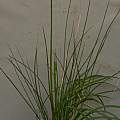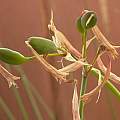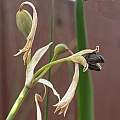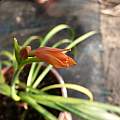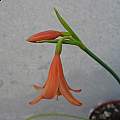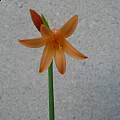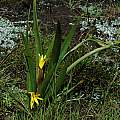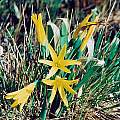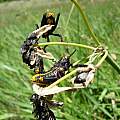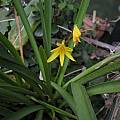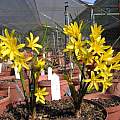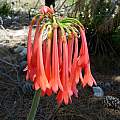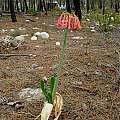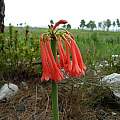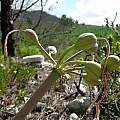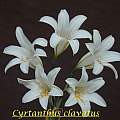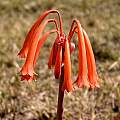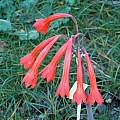Cyrtanthus is a large genus of the Amaryllidaceae family native to South Africa.
Cyrtanthus species a-c are found on this wiki page
Cyrtanthus hybrids - Cyrtanthus d-j - Cyrtanthus k-o - Cyrtanthus p-z - Cyrtanthus index
Cyrtanthus angustifolius (L.f.) Aiton is found on mountain slopes and flats in seasonal streams and marshes. It flowers spring to summer, occasionally in winter after a fire. Growing up to 45 cm, the bright red flowers are pollinated by sunbirds. The first photo taken in a burned area (Sandy's Glen) in the Overberg by Cameron McMaster. The second photo from the book Plants of the Klein Karoo courtesy of Jan and Anne Lise Schutte-Vlok.
Cyrtanthus brachyscyphus Baker is found in moist grassland or rocky streambanks in the Eastern Cape and KwaZulu-Natal. Although it is not as flashy or as big as other species, it is one of the easiest of the genus to grow. Flowers vary depending on the clone, but typically they have nice orange flowers and often remain evergreen in cultivation. Their main flowering period is in spring and summer, and they make good container and garden subjects. This one started blooming in February 2003 and is still blooming in May 2003. Height: 30 cm. Photos by Bob Rutemoeller, Mary Sue Ittner, Susan Hayek for Diana Chapman, Alessandro Marinello and Nhu Nguyen showing various clones in cultivation.
Photos by David Pilling, the second was taken using transmitted infrared light, it shows that most of what is shown in the first seed photo is a wing, and also what may be the embryo.
Photo 1 shows the resulting flowering plant around two years later; the pot is 3 inches high, a ruler is present. Photo 2 is of seed pods on the same plant many weeks later. Photo 4 is of one of the bulbs - this was taken a year after the seed pod photos, and this bulb has been poking out of the ground for sometime, which may have some bearing on its colour; compare with the smaller bulb in the photo; the scale is in mm.
Cyrtanthus brachysiphon Hilliard & B.L.Burtt is native to KwaZulu-Natal where it is found on moist rock ledges near waterfalls. It grows to 16 cm. Photos from Alessandro Marinello.
Cyrtanthus breviflorus Harv. is found in marshy, grassy places up to 3000 m from the Eastern Cape to Kenya. It has bright yellow flowers and flowers mainly in spring and summer, but sporadic blooms may appear throughout the season. It is part of the fire lily group and would normally need fire to stimulate flowering, but Greg Pettit has managed to get a clone from the swamps that thrives in water, and produces up to 14 canary yellow flowers per plant. Height range: 10-30 cm. The first two photos were taken by Mary Sue Ittner at Naude's Nek in the Eastern Cape showing a plant with leaves, flowers, and seed pods. The next three photos were taken by Cameron McMaster, including one showing locusts on the seed pods
This first photo taken by Bob Rutemoeller shows plants blooming in Harry Hay's gardens in May 2004. The second photo below is of a very floriferous form with semi-terete, succulent leaves - a real beauty! It grows (in profusion) on a hillside near the city of Pietermaritzburg, KwaZulu-Natal. Photo (excuse the distracting background!) by Rogan Roth. The last photo from Byron Amerson is an image of 2 month old seedlings sown from seeds purchased from Silverhill Seeds.
Cyrtanthus carneus Lindl. is one of the largest Cyrtanthus in the genus, growing very old and developing massive bulbs. It is also very rare and localised and most populations are severely threatened by alien vegetation. It is evergreen and has long, broad tough leaves. We have found it in a few places growing in fynbos in acid table mountain sandstone soil - in valleys on the northern side of the mountains near Napier where we live. It is shy to flower but when it does, it has very large flowers borne on stems up to 70 cm high. Capsules take a long time to mature and ripen. Photos by Cameron McMaster of plants in habitat in the Overberg including the last of seed capsules.
Cyrtanthus clavatus (L'Hér.) R.A.Dyer is a dwarf, white, cream or pale pink-flowering species from the Eastern Cape, with red-brown or green median stripes. It is dormant in winter and flowers in summer, and the bulbs should be planted with the necks just above ground level. Photo by Bill Dijk
Cyrtanthus contractus N.E.Br. is widespread in the Eastern Cape where it is found from the inland areas northward. It occurs in various habitats, sometimes in open grassland where it flowers in October or earlier if stimulated by fire. The photos below were taken by Cameron McMaster from habitat.
The photos below were from Digby Boswell and Uluwehi Knecht of plants in cultivation.
Cyrtanthus hybrids - Cyrtanthus d-j - Cyrtanthus k-o - Cyrtanthus p-z - Cyrtanthus index
